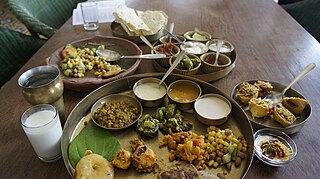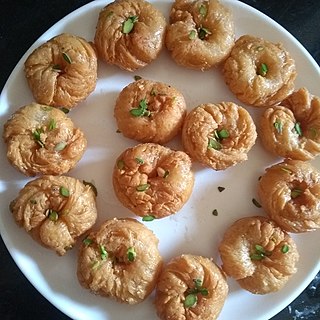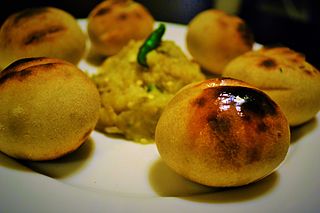
Benincasa hispida, the wax gourd, also called ash gourd, white gourd, winter gourd, winter melon, tallow gourd, ash pumpkin, Chinese preserving melon is a vine grown for its very large fruit, eaten as a vegetable when mature. It is the only member of the genus Benincasa.

Punjabi cuisine is a culinary style originating in the Punjab, a region in the northern part of South Asia, which is now divided in an Indian part to the east and a Pakistani part to the west. This cuisine has a rich tradition of many distinct and local ways of cooking.

Tamil cuisine is a culinary style of Tamil people originating in the southern Indian state of Tamil Nadu and neighboring Sri Lanka. Meats, along with rice, legumes, and lentils, are also popular. Dairy products and tamarind are used to provide sour flavors. On special occasions, traditional Tamil dishes are served in a traditional manner, using banana leaves in place of utensils. After eating, the banana leaves are then used as a secondary food for cattle. A typical breakfast meal consists of idli or dosa with chutney. Lunch includes rice, sambar, curd, kuzhambu, and rasam.

Rajasthani cuisine is the cuisine of the Rajasthan state in North West India. It was influenced by various factors like the warlike lifestyles of its inhabitants, the availability of ingredients in an arid region and by Hindu temple traditions of sampradayas like Pushtimarg and Ramanandi. Food that could last for several days and could be eaten without heating was preferred. Scarcity of water and fresh green vegetables have all had their effect on the cooking. Signature Rajasthani dishes include Dal Baati Churma, Panchratna Dal, Papad ro Saag, Ker Sangri, Gatte ro Saag. It is also known for its snacks like Bikaneri bhujia, Mirchi bada and Kanda kachauri. Other famous dishes include Dal Baati, malaidar special lassi (lassi) and Lashun ki chutney, Mawa lassi from Jodhpur, Alwar ka mawa, Malpauas from Pushkar and rasgulla from Bikaner, "paniya"and "gheriya" from Mewar. Originating for the Marwar region of the state is the concept Marwari Bhojnalaya, or vegetarian restaurants, today found in many parts of India, which offer vegetarian food of the Marwari people. The history also has its effect on the diet as the Rajputs preferred majorly a non-vegetarian diet while the Brahmin, Jains, and others preferred a vegetarian diet. So, the state has a myriad of both types of delicacies.

Puran poli is an Indian sweet flatbread that popular in South India and the state of Maharashtra. It is also known as Puran puri, Holige, Obbattu, Bobbattlu, Poley, Bakshamulu, and Boli.

Palak paneer or Palak Chhena is an Indian dish consisting of chhena or paneer in a thick paste made from puréed spinach, called palak in Hindi, Marathi, Gujarati, and other Indian languages.

Gujarati cuisine is the cuisine of the Indian state of Gujarat. The typical Gujarati thali consists of rotli, dal or curry, rice, and shaak. The thali will also include preparations made from pulses or whole beans such as moong, black eyed beans etc., a snack item (farsaan) like dhokla, pathra, samosa, fafda, etc. and a sweet (mishthaan) like mohanthal, jalebi, sevaiya etc.

Odia cuisine is the cuisine of the Indian state of Odisha. Compared to other regional Indian cuisines, Odia cuisine uses less oil and is less spicy, while nonetheless remaining flavourful. Rice is the staple food of this region. Mustard oil is used in some dishes as the cooking medium, but ghee is preferred in temples. Odia foods traditionally served either on brass, bronze metal plates, banana leaf or disposable plates made of sal leaves.

Dahi puri is an Indian snack food which is especially popular in the state of Maharashtra. The dish is a type of chaat and originates from the city of Mumbai. It is served with mini-puri shells (golgappa), which are also used for the dish pani puri. Dahi puri and pani puri chaats are often sold by the same vendor.

Undhiyu is a Gujarati mixed vegetable dish that is a regional specialty of Surat, Gujarat, India. The name of this dish comes from the Gujarati word "undhu", which translates to upside down, since the dish is traditionally cooked upside down underground in earthen pots, termed "matlu", which are fired from above.

Kadhi, or karhi, is a popular dish mainly consumed in South Asia. It consists of a thick gravy or soup based on gram flour, and it may contain vegetable fritters called pakora, which include dahi (yogurt) for a sour taste. It is often eaten with cooked rice or roti. Varieties of kadhi include those from Rajasthan, Maharashtra, Gujarat, Punjab, and Sindh, all of which are located in present-day India and Pakistan.

Pithas are a variety of food similar to pancakes, dumplings or fritters, originating from the Indian subcontinent, common in Bangladesh and India. Pitha can be sweet or savoury, and usually made from a dough or batter, which is then steamed, fried or griddled. Very few varieties are oven-baked or boiled, and most are unleavened and cooked on a stovetop. Some versions may have a filling, garnish, or sauce. Few may be set or shaped after cooking. They are typically eaten as a snack with chai, or as treats during special occasions.
Bhojpuri cuisine is a style of food preparation common among the Bhojpuri people of Bihar and eastern Uttar Pradesh in India, and also the Terai region of Nepal. Bhojpuri foods are mostly mild and tend to be less hot in terms of spices used. The cuisine consists of both vegetable and meat dishes.

Ragi mudde, ragi sangati or kali, colloquially simply referred to as either mudde or hittu which means 'lump' or 'dough' is a finger millet swallow dish of India in the state of Karnataka and Andhra Pradesh. In Tamil Nadu, especially in western Tamil Nadu, it is also called ragi kali. Ragi mudde is the main food in Kolar, Mandya, Hassan, Mysore, Tumkur districts in Karnataka and Rayalaseema Region in Andhra Pradesh. A similar variation known as Dhindo is also eaten in Northeast India, Nepal and Bhutan. In Uttarakhand and Himachal Pradesh in northern India, a similar variation is known as Baadi and Baari respectively.

Sabudana khichri is an Indian dish made from soaked sabudana. It is the dish of choice when an individual observes a "fast" during Shivratri, Navratri, or a similar Hindu religious occasion.

Makhan Bada is a traditional dessert originating from the Indian subcontinent. It is also known as Balusaahi and is similar to a glazed doughnut in terms of Ingredients, but differs in texture and taste. Makhan Bada also resembles Rajasthani Baati in terms of size & preparation but resembles more with Medu Vada in terms of shape. In South India, a similar pastry is known as badusha.
Bihari cuisine is eaten mainly in the eastern Indian state of Bihar, as well as in the places where people originating from the state of Bihar have settled: Jharkhand, Eastern Uttar Pradesh, Bangladesh, Nepal, Mauritius, South Africa, Fiji, some cities of Pakistan, Guyana, Trinidad and Tobago, Suriname, Jamaica, and the Caribbean. Bihari cuisine includes Bhojpuri cuisine, Maithil cuisine and Magahi cuisine.

Solkadhi is a type of drink, an appetizer originating from the Indian subcontinent, usually eaten with rice or sometimes drunk after or along with the meal. Popular in the Konkan regions, especially Goa and parts of coastal Maharashtra, it is made from coconut milk and dried kokum skins, whose anthocyanin pigments provide a deep purple-pink colour.

Litti is a whole wheat flour dough ball stuffed with a spiced mixture of sattu. Litti, along with chokha, is a complete meal that originated from the Bhojpuri region of the Indian states of Bihar and Uttar Pradesh. Traditionally, the wheat dough balls are roasted on hot charcoal or dried cow dung fire. They can also be baked in an oven, roasted on a tava or fried.

Maithil cuisine, also known as Mithila cuisine, is a part of Indian and Nepalese cuisine. It is the traditional cooking style of Maithils residing in the Mithila region of the subcontinent.


















